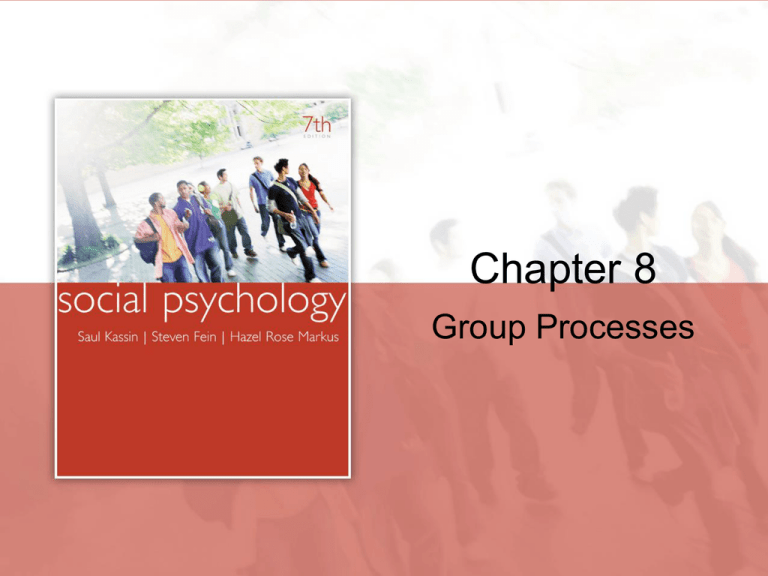
Chapter 8
Group Processes
Individuals in Groups
The Presence of Others
Copyright © Houghton Mifflin Company. All rights reserved.
8|2
What is a Group?
• A set of individuals who have at least one of the
following characteristics:
– Direct interactions with each other over a period of
time
– Joint membership in a social category based on sex,
race, or other attributes
– A shared, common fate, identity, or set of goals
Copyright © Houghton Mifflin Company. All rights reserved.
8|3
What Is a Collective?
• An assembly of people engaging in a common
activity but having little direct interaction with
each other.
– Not a real group
• Some social psychological processes are unique
to real groups.
– However, others affect both groups and collectives
Copyright © Houghton Mifflin Company. All rights reserved.
8|4
Social Facilitation:
When Others Arouse Us
• How does the presence of others affect our
behavior?
• Triplett’s (1897-1898) fishing reel studies.
• Later research found conflicting findings.
– Sometimes the presence of others enhanced
performance.
– At other times, performance declined.
• What was going on???
Copyright © Houghton Mifflin Company. All rights reserved.
8|5
Figure 8.1: Social
Facilitation: The Zajonc Solution
Copyright © Houghton Mifflin Company. All rights reserved.
8|6
Why Does Social Facilitation Occur?
• Zajonc’s Mere Presence Theory
• Evaluation Apprehension Theory
– Someone must be in position to evaluate
performance.
– Stereotype threat revisited.
Copyright © Houghton Mifflin Company. All rights reserved.
8|7
Why Does Social
Facilitation Occur? (cont.)
• Distraction Conflict Theory
– Attentional conflict between focusing on task and
inspecting the distracting stimulus creates arousal.
– Maintains there is nothing uniquely social about
“social” facilitation.
• Which theory is correct?
Copyright © Houghton Mifflin Company. All rights reserved.
8|8
Putting Common Sense to the Test…
People will cheer louder when they cheer as part
of a group than when they cheer alone.
Answer: False… Let’s see why!
Copyright © Houghton Mifflin Company. All rights reserved.
8|9
Social Loafing: When Others Relax Us
• Ringelmann (1880s): Individual output declines
on pooled tasks.
• Social Loafing: A group-produced reduction in
individual output on easy tasks in which
contributions are pooled.
Copyright © Houghton Mifflin Company. All rights reserved.
8 | 10
Figure 8.2: Social Loafing:
When Many Produce Less
Adapted from Jackson & Williams, 1985; Sanna, 1992.
Copyright © Houghton Mifflin Company. All rights reserved.
8 | 11
When Is Social
Loafing Less Likely to Occur?
• People believe that their own performances can
be identified and thus evaluated, by themselves
or by others.
• The task is important or meaningful to those
performing it.
• People believe that their own efforts are
necessary for a successful outcome.
Copyright © Houghton Mifflin Company. All rights reserved.
8 | 12
When Is Social
Loafing Less Likely to Occur? (cont.)
• The group expects to be punished for poor
performance.
• The group is small.
• The group is cohesive.
Copyright © Houghton Mifflin Company. All rights reserved.
8 | 13
Why Does Social Loafing Occur?
• Collective Effort Model: Individuals try hard on
a collective task when they think their efforts
will help them achieve outcomes they
personally value.
Copyright © Houghton Mifflin Company. All rights reserved.
8 | 14
Figure 8.3: Unifying the
Paradigms: Presence and Evaluation
Adapted from Jackson & Williams, 1985; Sanna, 1992.
Copyright © Houghton Mifflin Company. All rights reserved.
8 | 15
Deindividuation
• The loss of a person’s sense of individuality and
the reduction of normal constraints against
deviant behavior.
– A collective phenomenon that only occurs in the
presence of others
• What can lead to deindividuation?
Copyright © Houghton Mifflin Company. All rights reserved.
8 | 16
Environmental Cues
• Accountability cues affect the person’s costreward calculations.
• Attentional cues focus a person’s attention away
from the self.
Copyright © Houghton Mifflin Company. All rights reserved.
8 | 17
Figure 8.4: Deindividuation
and Social Identity
From Johnsson, R.D., and Downing, L. L. (1979). "Deindividuation and valance of cues: Effects on prosocial and antisocial behavior."
Copyright © Houghton Mifflin Company. All rights reserved.
8 | 18
Group Dynamics
Interacting with Others
Copyright © Houghton Mifflin Company. All rights reserved.
8 | 19
Why Join a Group?
• We may have an innate need to belong to
groups.
• Groups help us to accomplish things we cannot
accomplish as individuals.
• Groups offer social status and identity.
• We like the members and want to have the
opportunity to interact with them.
Copyright © Houghton Mifflin Company. All rights reserved.
8 | 20
Table 8.1: Stages
of Group Development
Copyright © Houghton Mifflin Company. All rights reserved.
8 | 21
Group Roles
• People’s roles in a group can be formal or
informal.
• Two fundamental types of roles:
– An instrumental role to help the group achieve
its tasks
– An expressive role to provide emotional support
and maintain morale
Copyright © Houghton Mifflin Company. All rights reserved.
8 | 22
Group Norms
• Groups establish norms or rules of conduct
for members.
• Norms may be either formal or informal.
Copyright © Houghton Mifflin Company. All rights reserved.
8 | 23
Group Cohesiveness
• The forces exerted on a group that push its
members closer together.
• Cohesiveness and group performance are
causally related.
– But relationship is complex
Copyright © Houghton Mifflin Company. All rights reserved.
8 | 24
Putting Common Sense to the Test…
Group members’ attitudes about a course of action
usually become more moderate after group
discussion.
Answer: False… Let’s see why!
Copyright © Houghton Mifflin Company. All rights reserved.
8 | 25
Group Polarization
• Conflicting findings about the types of decisions
groups make:
– Sometimes riskier, other times more cautious
• Group Polarization: The exaggeration through
group discussion of initial tendencies in the
thinking of group members.
Copyright © Houghton Mifflin Company. All rights reserved.
8 | 26
What Creates Group Polarization?
• Persuasive arguments theory
• Social comparison
• Social categorization
Copyright © Houghton Mifflin Company. All rights reserved.
8 | 27
Groupthink
• Excessive tendency to seek concurrence among
group members.
• Emerges when the need for agreement takes
priority over the motivation to obtain accurate
information and make appropriate decisions.
Copyright © Houghton Mifflin Company. All rights reserved.
8 | 28
Antecedents of Groupthink
• Highly cohesive groups
• Group structure
–
–
–
–
Homogeneous members
Isolation
Directive leadership
Unsystematic procedures
• Stressful situations
Copyright © Houghton Mifflin Company. All rights reserved.
8 | 29
Symptoms of Groupthink
• Overestimation of the group
• Closed-mindedness
• Increased pressures toward uniformity
– Mindguards and pressures towards uniformity
– Self-censorship
– Illusion of unanimity
Copyright © Houghton Mifflin Company. All rights reserved.
8 | 30
Consequences of Groupthink
• Defective decision making
–
–
–
–
–
–
Incomplete survey of alternatives
Incomplete survey of objectives
Failure to reappraise initially rejected alternatives
Poor information search
Selective bias in processing information at hand
Failure to work out contingency plans
• High probability of a bad decision
Copyright © Houghton Mifflin Company. All rights reserved.
8 | 31
Figure 8.5: Charting
the Course of
Groupthink
Copyright © Houghton Mifflin Company. All rights reserved.
8 | 32
Preventing Groupthink
• Avoid isolation by consulting widely with
outsiders.
• Leaders should reduce conformity pressures.
• Establish a strong norm of critical review.
Copyright © Houghton Mifflin Company. All rights reserved.
8 | 33
Table 8.2: How Computerized Group
Support Systems Help Groups Avoid Groupthink
Copyright © Houghton Mifflin Company. All rights reserved.
8 | 34
Group Performance: Are
More Heads Better than One?
• Additive Tasks: Groups usually outperform single
individuals.
• Conjunctive Tasks: Group performance tends to
be worse than the performance of a single,
average individual.
• Disjunctive Tasks: Process loss can occur.
Copyright © Houghton Mifflin Company. All rights reserved.
8 | 35
Setting Goals
• Better if group has specific, challenging, and
reachable goals.
• Goals selected by groups tend to be less
ambitious.
– But still typically perform better than groups without
goals.
– As gain more experience, begin to set more
challenging goals.
Copyright © Houghton Mifflin Company. All rights reserved.
8 | 36
Putting Common Sense to the Test…
People brainstorming as a group come up with a
greater number of better ideas than the same
number of people working individually.
Answer: False… Let’s see why!
Copyright © Houghton Mifflin Company. All rights reserved.
8 | 37
Brainstorming: Coming Up with Ideas
• A technique that attempts to increase the
production of creative ideas by encouraging
group members to speak freely without
criticizing their own or others’ contributions.
Copyright © Houghton Mifflin Company. All rights reserved.
8 | 38
Table 8.3: Brainstorming
in Groups: Problems and Solutions
Copyright © Houghton Mifflin Company. All rights reserved.
8 | 39
Table 8.3: Why Electronic
Brainstorming is Effective
Copyright © Houghton Mifflin Company. All rights reserved.
8 | 40
Biased Sampling and Communication
• On some tasks, simply sharing information is
crucial for good performance.
• But all the information available to individual
members may not be brought before the group.
– Biased sampling
• If inadequately informed, the group may make a
bad decision.
Copyright © Houghton Mifflin Company. All rights reserved.
8 | 41
When Is Biased Sampling
Less Likely to Occur?
• When group members are aware that not
everyone has access to the same information.
• Leaders encourage group participation.
• At least two group members know the
uncommon information.
Copyright © Houghton Mifflin Company. All rights reserved.
8 | 42
Figure 8.6: Sharing Information
in a Group: The Role of Group Norms
From T. Postmes, R. Spears, and S. Cihagir, "Quality of Decision Making and Group Norms,"
Journal of Personality and Social Psychology, 80, 918-930, 2001. Copyright © 2001 by the
American Psychological Association. Reprinted with permission.
Copyright © Houghton Mifflin Company. All rights reserved.
8 | 43
Putting Common Sense to the Test…
Groups are less likely than individuals to invest
more and more resources in a project that is
failing.
Answer: False… Let’s see why!
Copyright © Houghton Mifflin Company. All rights reserved.
8 | 44
Escalation Effects
• Occurs when commitment to a failing course of
action is increased to justify previous
investments.
• Groups more likely to escalate commitment.
– Also likely to do it in more extreme ways.
Copyright © Houghton Mifflin Company. All rights reserved.
8 | 45
Information Processing
• How well do group members process
information compared with individuals?
• Groups are also susceptible to information
processing biases.
• Through transactive memory, groups remember
information more efficiently than individuals.
– But process loss can still occur.
Copyright © Houghton Mifflin Company. All rights reserved.
8 | 46
Diversity and Group Performance
• Diversity often associated with negative group
dynamics.
– But diversity can have positive effects.
• Diversity can enhance a group’s performance if
the group is integrated.
Copyright © Houghton Mifflin Company. All rights reserved.
8 | 47
Cooperation,
Competition, and Conflict
Copyright © Houghton Mifflin Company. All rights reserved.
8 | 48
Social Dilemmas
• Situations in which a self-interested choice by
everyone creates the worst outcome for
everyone.
– What is good for one is bad for all.
Copyright © Houghton Mifflin Company. All rights reserved.
8 | 49
Figure 8.7: The Prisoner’s Dilemma
Copyright © Houghton Mifflin Company. All rights reserved.
8 | 50
Strategies Used When
Facing Mixed-Motive Situations
• Tit-for-Tat
• Win-Stay, Lose-Shift
Copyright © Houghton Mifflin Company. All rights reserved.
8 | 51
Putting Common Sense to the Test…
Large groups are more likely than small groups to
exploit a scarce resource that the members
collectively depend on.
Answer: True… Let’s see why!
Copyright © Houghton Mifflin Company. All rights reserved.
8 | 52
Resource Dilemmas
• Social dilemmas concerning how two or more
people share a limited resource.
• Two types of resource dilemmas:
– Commons dilemma (“take-some dilemma”)
– Public goods dilemma
Copyright © Houghton Mifflin Company. All rights reserved.
8 | 53
Table 8.4:
Solving Social
Dilemmas
Copyright © Houghton Mifflin Company. All rights reserved.
8 | 54
Figure 8.8: Culture
and the Prisoner's Dilemma
Copyright © Houghton Mifflin Company. All rights reserved.
8 | 55
Table 8.5: Factors that Promote and
Sustain the Escalation of Between-Group Conflict
Copyright © Houghton Mifflin Company. All rights reserved.
8 | 56
Reducing Conflict: Through GRIT
• Graduated and Reciprocated Initiatives in
Tension-Reduction (GRIT)
– A strategy for unilateral, persistent efforts to establish
trust and cooperation between opposing parties.
• GRIT is a reciprocal, tit-for-tat strategy.
Copyright © Houghton Mifflin Company. All rights reserved.
8 | 57
Negotiation
• Integrative agreement is a negotiated resolution
where all parties obtain outcomes that are
superior to a 50-50 split.
• Key elements in successful negotiating include:
– Flexibility and strength
– Communicating and trying to understand the point of
view of the other person
Copyright © Houghton Mifflin Company. All rights reserved.
8 | 58
Table 8.6:
Cultural Assumptions
About Negotiating
Copyright © Houghton Mifflin Company. All rights reserved.
8 | 59
Finding A Common Ground
• Recognition of a superordinate identity.
• Superordinate goals can elicit cooperation by
appealing to people’s self-interest.
– These goals can also produce a superordinate
identity.
Copyright © Houghton Mifflin Company. All rights reserved.
8 | 60







